SB 1383 Compliance: Organic Waste to Renewable Fuel and Fertilizer
- July 18, 2022
- Anaergia's California Team
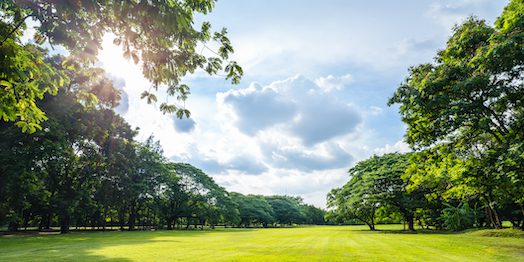
A ROADMAP TO 75% ORGANICS DIVERSION BY 2025:
- Separate organic waste from landfill-bound waste
- Transform organics into valuable resources
SB 1383: What’s in It?
California’s new organic waste mandate—Senate bill (SB) 1383 (2016)—set a goal of diverting 75% of organic waste, equivalent to 20 million tons per year, from statewide landfills by 2025. To achieve this ambitious target, California will need to construct 100 to 200 additional organic waste recycling facilities, in addition to the roughly 200 existing facilities (Calrecycle).
The regulation, which applies to municipal and commercial sources, requires that the landfill-diverted organics be transformed into valuable resources: fertilizer and renewable energy. State enforcement will commence on January 1, 2022 with penalties for non-compliance up to $10,000 per day. These changes require local governments, in conjunction with waste haulers, to deploy and implement new organic waste management, recycling, and processing procedures and systems, and new organic recycling infrastructure.
SB 1383 Implementation Timeline

Organics Collection & Compliance Requirements
SB 1383 requires jurisdictions to collect solid waste from generators using 1, 2, or 3 bins. CalRecycle specifies bin color coding as follows: Black for trash, Blue for recyclables, and Green for yard waste. Organics are required to be separated out of the solid waste stream by one of two methods: (1) manually by the generator at their residence or place of work, or (2) after collection at a centralized High Diversion Organic Waste Processing Facility (HDOWPF).
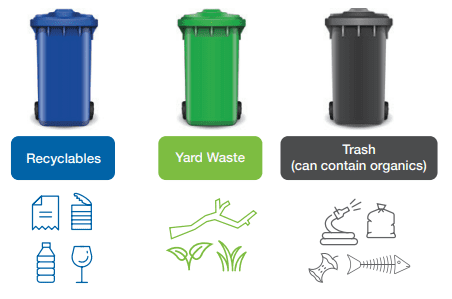
CalRecycle will require monitoring for either strategy, as follows:
- Manual Separation by Generators: Generators must be educated to remove organic waste from the black bin and place it into the green bin or a dedicated food waste bin. Black bin MSW will then be monitored by waste audits or route reviews to ensure no more than 25% organics remain.
- HDOWPF Separation: Organic waste can remain in the black bin if processed at a HDOWPF. HDOWPF must capture 75% organics with no more than 10% contamination in the recovered organic strea
In addition, jurisdictions are required to procure quantities of fertilizer and renewable natural gas (RNG) generated from recycled organic waste that is proportional to its population.
Contamination is a significant concern for Source Separated Organics (SSO) programs. Even with extensive and costly public education programs, contamination rates can still be high.

Collection Options: 1, 2, or 3+ Bins
Solid waste haulers and municipalities have options for collecting Municipal Solid Waste (MSW). Each has implications for cost, collection effort, education/outreach, and new solid waste management facilities and equipment.
One bin collection (black bin only) allows residents to leave all waste and recyclable materials into the black bin. Users are not required to sort or separate anything, and there is no need to rely on generators to sort or separate waste. Jurisdictions with a 1-bin collection system will rely on downstream separation at a HDOWPF.
Two bin collection includes a black bin for mixed MSW and a blue bin for non-organic recyclables. Generators can leave organics in the black bin as mixed MSW. Under this scenario, the black bin, containing the organics, is sent to the HDOWPF for organics separation.
Three bin collection includes a black bin for mixed MSW, a blue bin for non-organic recyclables, and a green bin for yard waste. A fourth bin can be added, as an option, for dedicated food waste separation.
A three bin strategy requires the jurisdiction to choose a separation strategy:
- Black Bin Organics management allows residents to leave organics in the black bin, which is then routed to a HDOWPF for separation. This solution achieves 75% organics capture using a technology-based solution at the HDOWPF. This option avoids the need for additional education / outreach, does not rely on generators to separate their own waste, and ensures all organic waste is processed.
- Separated Organics. Organics must be moved to the yard waste bin or to a separate (new/fourth) organics bin. This strategy relies solely on generators/human behavior to separate organic waste and requires extensive and continuous education to ensure organics are separated out of the black bin to below 25% content.
Many jurisdictions will have combinations of 1, 2, and 3 bin collection strategies for various sectors (i.e. 3-bin residential, 2-bin multifamily and commercial).
A centralized technology solution at a HDOWPF that processes and recovers organics from black bin waste is compatible with any collection strategy and ensures all organic waste is processed for compliance.
SSO TO COMPOST, OR MSW TO AD:
Which is Right for You?
Two prevailing methods to divert organic waste from landfills allowed under SB 1383 are: (1) mixed waste collection with organics separation at a HDOWPF to Anaerobic Digestion (AD), or (2) source separated organics collection to composting (source separated organics to AD is also possible).
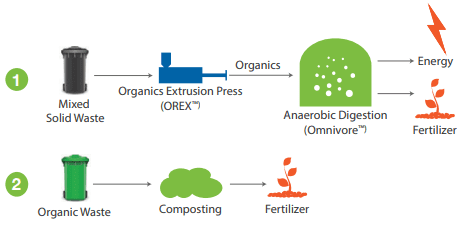

With mixed collection to AD, organics can be separated from MSW using Anaergia’s Organics Extrusion Press (OREX) and fed to an anaerobic digester at a Wastewater Treatment Plant (WWTP) to generate renewable energy. This approach utilizes existing infrastructure within the community to generate energy and fertilizer. In contrast, collecting organics in source separated bins is more costly, adds trucks to the road, and sending organics to compost facilities generates fertilizer that is volatile in value and thus causes capacity and tip fees to fluctuate unpredictably. Mixed waste collection and processing at HDOWPF’s leverage local and existing anaerobic digestion infrastructure. This strategy avoids additional collection cost, new truck routes, and reliance on human separation. This strategy also provides certainty in processing all organics with reliable and long term fixed price capacity at anaerobic digestion facilities.
| Mixed Collection to AD versus Separate Collection to Composting | ||
| Mixed Collection to AD | Separate Collection to Composting | |
| Organic Collection Cost | No change required | Up to 4x higher cost with new trucks, bins, routes, and education/outreach |
| Relies on Human Behavior for Compliance | No change in human behavior | Complete reliance on human behavior |
| Compliance Certainty | Certain by processing all waste using technology | Uncertainty by reliance on human separation to achieve <25% organics in black bin |
| Renewable Energy Recovery | Generate renewable fuel and energy | None |
| Green House Gas Impact | Carbon Negative | Carbon Positive |
| Fertilizer Generation | Yes | Yes |
| Organics Capacity and Cost Certainty | Long term firm capacity at fixed price, shields from market volatility | Short term capacity with exposure to tip fee volatility increasing with contamination and lower fertilizer value |
| Acceptable Food Waste Percentage | Up to 100%, no need to blend with green waste at set ratios | Typically requires blending with 50% green waste; operational constraints |
| Footprint | 1x | 5x |
| Infrastructure | Leverage existing local WWTP digester infrastructure | Reliance on composting facilities that might be located farther |
Summary of Costs for Source Separated Organic Waste to Compost and Mixed MSW to WWTP
Collection cost: Cost Projections for Transfer, Haul, and Disposal of Municipal Solid Waste, Goldsmith Resources LLC, 2014 (MSW), Further Evaluation of
Organics Management Options, Capitol Public Finance Group, 2015 (SSO)
Processing Cost: Assumes typical costs for capital equipment purchases, operating expenses, and fixed facility costs.
Transportation and disposal: Assumes tip fee of $55/ton for both compost and AD site; transportation for compost site of $20/ton (50 miles) and local wastewater plant digestion of $10/ton (<20 miles).
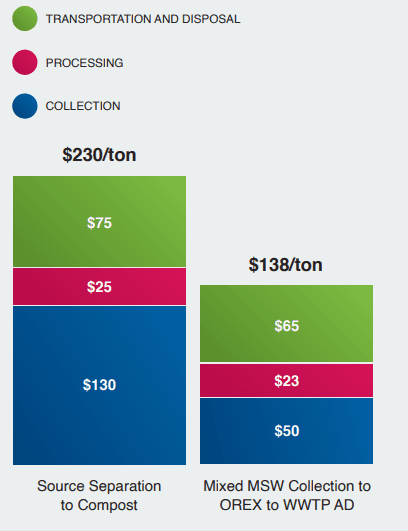
STREAMLINED ORGANICS:
High Diversion Organic Waste Recycling Facility with OREX
Anaergia’s organic waste processing systems rely on robust technologies placed in existing solid waste transfer stations or MRFs. Regulatory compliance is ensured by capturing organics from all solid waste streams in a closed system. The organic product recovered is a clean and consistent feedstock for anaerobic digestion at a local WWTP.
Anaergia offers customized solutions, from MSW organics separation through AD energy conversion, to help virtually any waste manager or municipality cost-effectively manage organic waste and comply with SB 1383.

Anaergia’s OREX Systems
Anaergia’s Organics Extrusion Press (OREX) separates organics from MSW as well as contaminated SSO streams. The OREX fits within a sophisticated waste processing line that recovers metals, recyclables, and organics with multiple machines. The OREX is a high pressure extrusion system applying up to 7,000 psi of pressure to drive organic materials through a perforated extrusion plate and retain residuals inside the chamber. The OREX coupled with polishing produces a clean organic fraction for AD with an ultra low contamination level of <0.3% dry basis of inerts >4 mm, exceeding Calrecycle standards (0.5% dry basis, >4 mm).
| Contaminant Category | OREX Organic Fraction after Downstream Polishing System (>2mm, % dry basis) | CalRecycle Standard (>4mm, % dry basis) |
| Rigid Plastic | 0.05% | |
| Film Plastic | 0.08% | <0.1% |
| Metal | 0.06% | |
| Glass | 0.03% | |
| Total | 0.21% | <0.5% |

“This technology expands our capability as a leader in organics recycling and sustainability by recovering organics from the waste stream and meeting the current and future organics diversion needs of Los Angeles.”
– Larry Metter, Area Vice President for Waste Management of Southern California


CLOSING THE LOOP:
AD Integration with Existing Local Wastewater Treatment Plants
Diverting organics from solid waste to anaerobic digesters at local WWTPs cost effectively leverages local existing infrastructure and provides reliable long term committed capacity with cost certainty. Most communities benefit from local organics recycling capacity in over 150 California WWTPs with existing anaerobic digestion. Retrofitting WWTP digesters with Anaergia AD technology creates capacity for organics digestion and generation of renewable energy and fertilizer. Anaergia offers technology packages with turnkey design, construction, financing, and operations, all based in California, to convert WWTPs into organic recycling infrastructure. Anaergia invests in infrastructure at Transfer Stations / MRFs, WWTPs, and brownfield sites to deliver turkney service solutions as Public Private Partnerships (P3).
Rialto Bioenergy Facility (RBF), Rialto, CA:
The Rialto Bioenergy Facility (RBF) is the largest landfill diverted organic waste digester facility in North America addressing two pressing waste management issues in Southern California: food waste diversion from landfills and biosolids management. RBF converts 700 tons per day of landfill diverted organic waste and 300 tons per day of biosolids into renewable natural gas, renewable electricity, and Class A fertilizer. Organic waste feedstock is provided by a state-of-the-art solid waste processing line that uses Anaergia’s OREX technology to extract the organic fraction from solid waste. The OREX operates at Waste Management’s Sun Valley Recycling Park in Sun Valley, CA servicing the greater Los Angeles metro region. At RBF, the organic waste is converted into RNG using Anaergia’s advanced anaerobic digestion technology that operates at three times higher throughput than conventional anaerobic digestion. The facility serves the Southern California region as a regional organic recycling outlet with a net carbon dioxide emissions reduction of approximately 220,000 metric tons annually – equivalent to taking nearly 50,000 cars off the road. RBF is designed, built, owned, operated, and financed by Anaergia.

“We receive over 221,000 tons of garbage annually at the Shoreway Environmental Center. About 30% of this material is still made up of organic material. This pilot project will help move these materials out of the landfill and create a clean energy source for our operations.”
– Joe La Mariana, RethinkWaste Executive Director
South Bayside Waste Management Authority (SBWMA), San Carlos, CA:
The South Bayside Waste Management Authority (SBWMA), also known as RethinkWaste, is continuing its efforts in landfill diversion by converting organic waste into a renewable energy source at wastewater plants. SBWMA’s “Organics-to-Energy” (O2E) project uses Anaergia’s Organics Extrusion Press (OREX), located at the Shoreway Environmental Center, to extract the organic fraction from MSW and SSO streams to generate renewable energy at multiple regional wastewater treatment plants. The facility will divert up to 200 TPD of organic waste to regional wastewater treatment plants leveraging existing anaerobic digestion infrastructure.
“This type of innovation benefits our communities today with cleaner air and over the long term by reducing our county’s reliance on landfills”
– Carole Groom, SBWMA Supervisor
RethinkWaste is a regional solid waste joint powers authority of twelve public agencies (Atherton, Belmont, Burlingame, East Palo Alto, Foster City, Hillsborough, Menlo Park, Redwood City, San Carlos, San Mateo, the County of San Mateo and the West Bay Sanitary District) in San Mateo County, California and is a leader in the delivery of innovative waste reduction and recycling programs. RethinkWaste owns and manages the award winning Shoreway Environmental Center in San Carlos which receives all the recyclables, organic materials, and solid waste collected in its service area.
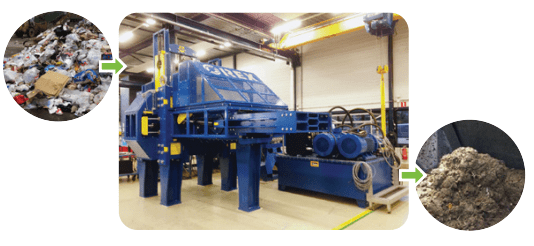
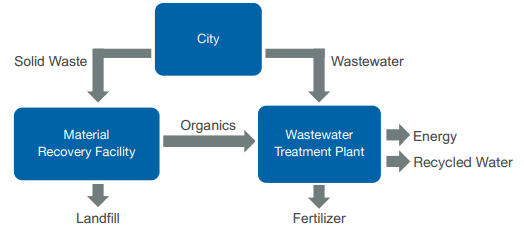



JOIN US IN THE FIGHT AGAINST CLIMATE CHANGE
Chat with us to discuss how we can work together to help communities, cities, industries to turn their waste into renewable fuel.

